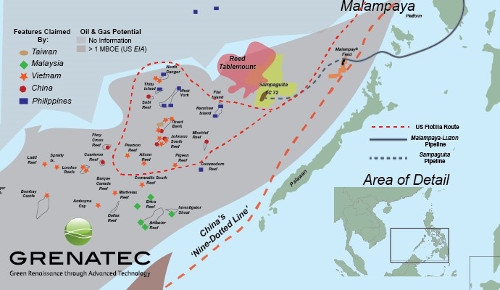 If US navy ships traverse the South China Sea to demonstrate freedom of navigation, what route might they take?
If US navy ships traverse the South China Sea to demonstrate freedom of navigation, what route might they take?
A US Navy flotilla tour of the South China could underscore Reed Bank's potential to provide a solution to territorial tension through Joint Development Areas.
One route could be a broad arc passing near Reed Bank as well as Subi and Mischief reefs. This would establish an important precedent in the most contentious areas of the South China Sea.
It would also demonstrate China's diplomatic isolation as the only nation likely to protest.
Advertisement
China claims virtually the entire South China Sea as 'indisputable' Chinese territory. China says it plans to ignore any international rulings that decide otherwise.
The US, along with all the South China Sea's other littoral nations, reject China's position.
The result of this disagreement between China and her neighbors has been testy encounters at sea - particularly between China, the Philippines and Vietnam. China's construction of military facilities on Subi, Mischief and Fiery Cross reefs (among others) increasingly worry her neighbors.
In mid-May, the Chinese navy ordered a US military reconnaissance flight away from Chinese claimed islands. The US ignored the order - claiming its flight path was in international airspace. The US may now underscore the point by sending US navy ships through the South China Sea to emphasize the principle of free maritime navigation.
If the US does so, the disputed Reed Bank - claimed by both China and the Philippines -is an excellent first stop on the tour. Reed Bank contains the South China Sea's most promising as-yet undeveloped oil and gas fields.
China and the Philippines already have engaged in dangerous skirmishes at Reed Bank as both conduct hydrographic research to better estimate the energy resource. This lifts the veil of principled subterfuge by all sides in the South China Sea. It shows the real issue lurking underneath.
Advertisement
South China Sea territorial claims - at least in Reed Bank - is really about energy.
If all sides recast dangerous nationalistic posturing to more hard-headed economic calculation, it opens the way for more rational, mutual gain negotiations. These could center upon joint development of South China Sea resources. This, as an alternative to war.
Nowhere at present offers the same opportunity as Reed Bank for rational thinking to prevail.
Discuss in our Forums
See what other readers are saying about this article!
Click here to read & post comments.
1 post so far.